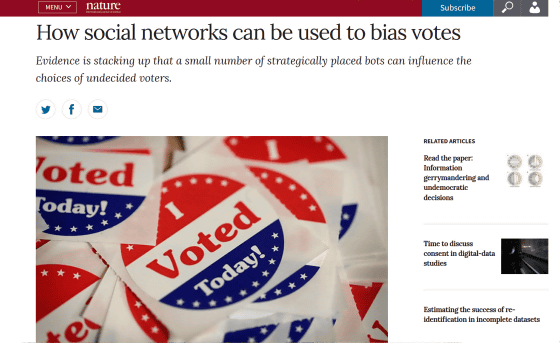Experiments show that a few bots active on SNS can influence the election results

by
In recent elections, SNS activities where Internet users gather have been regarded as important, and it is said that SNS played a major role in the birth of President Trump in the United States and the departure of the UK from the EU . Experiments conducted by a research team at the University of Houston, Texas have shown that a small number of strategically placed bots can influence the election outcome.
Information gerrymandering and undemocratic decisions | Nature
https://www.nature.com/articles/s41586-019-1507-6
How social networks can be used to bias votes
https://www.nature.com/articles/d41586-019-02616-2
How “information gerrymandering” influences according | MIT News
http://news.mit.edu/2019/information-gerrymandering-influences-voters-0904
How Do Social Networks Shape Political Decision-Making?-University of Houston
http://www.uh.edu/news-events/stories/2019/september-2019/09042019-stewart-information-gerrymandering.php

Associate professor
Then, on a virtual social network built for each group, they exchanged opinions with each other, worked on the other party, changed their opinions, and played an “election game” in which the winning party was decided by voting. It seems that the social network built for this experiment was close to “Small and simple Twitter”.
The research team has determined the extent to which each participant can interact with other participants on the social network, and 'all yellow party supporters and purple party supporters can interact' It seems that there were various patterns such as “cannot communicate with each other” and “only some participants can interact with supporters of other parties”.

by
It seems that the “election game” period for exchanging opinions and deciding which party to vote was 4 minutes per game, and the winning party was decided by the voting party at the end of that period. During the campaign period, participants are notified in real time how much support each party is attracting, and participants can see which party is dominant during the election period. It was possible to freely change the party that voted until the end.
As an incentive for the participants, if the “party first classified” wins by winning more than 60%, the opponent's camp wins a reward of $ 2 (about 210 yen) In some cases, 50 cents was paid. On the other hand, in the case of a draw where neither party was able to win more than 60% of the total, no reward was paid to either party.

by
In general, the participants voted for their party as they were when their party was dominant, and most of the participants voted for their party even when they were likely to draw. However, if the other party proved to be dominant, about half gave up their party to avoid a draw and voted for the other party, and the other half voted for their party. If the research team did not perform any special intervention, yellow won with a quarter probability, purple also with a quarter probability, and the remaining half of the game ended in a draw with no winner is.
Therefore, the research team also conducted an intervention experiment to introduce a small number of “enthusiast” bots that enthusiastically support one party in order to investigate the influence of bots on SNS. Bot never changed his opinion of supporting one party, and urged him to vote strongly for one party.
It seems that this enthusiastic bot had a significant impact on the outcome of the election game.For example, if a small number of yellow party support bots were introduced among many purple party supporters, the bot I was able to bring it to 'Yellow Political Party Support'. The enthusiastic bot activities fluctuated the minds of many participants, saying, “The other party is more dominant,” and as a result, voting was promoted to opposing political parties that were not originally supported political parties. The research team is watching.

Related Posts:
in Web Service, Science, Posted by log1h_ik







